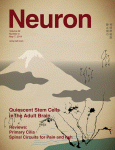脊髓延髓肌萎缩症(SBMA),有时也被称为肯尼迪氏病,是一种罕见的遗传性神经肌肉疾病,特点是缓慢渐进性肌肉无力和萎缩。研究人员一直认为它基本上损害初级运动神经元细胞(脊髓和脑干中控制肌肉运动的细胞)。
但发表在4月16日Neuron杂志上的一项新的研究中,美国加州大学医学院圣地亚哥分校医学院科学家利用新的小鼠模型研究表明,肌肉细胞突变体蛋白水平,而不是运动神经元病变,才是从根本上涉及SBMA的发生发展,这一新发现为替代治疗和有前途的新治疗途径带来新希望。
SBMA是一种X-连锁隐性遗传疾病,只影响男性。它属于如亨廷顿氏病的一组疾病,其中C-A-G DNA序列重复次数过多,导致蛋白质有过多的谷氨酰胺(一种氨基酸),从而引起病变蛋白错误折叠,并产生有害的后果。到目前为止,防止这些不良反应的重复人体临床试验都失败了。
在新的研究中, Albert La Spada博士为首的研究团队,提出了不同的治疗靶标。创建SBMA的一个新的小鼠模型后,他们发现骨骼肌是突变蛋白的毒性作用部位。在一篇发表在Cell Reports杂志上的相关论文中,La Spada和同事描述了SBMA的一个潜在的治疗方法。科学家开发反义寡核苷酸,即抑制外周组织中雄激素受体(AR)的基因表达,但对中枢神经系统AR无影响。AR基因突变是SBMA的原因,这一发现是由La Spada早期发现的。
La Spada说,反义治疗有助于在SBMA小鼠模型中恢复丢失的肌肉重量和力量,延长生存期。研究论文的主要观点是,我们已经至少在动物模型中确定基因治疗和药物治疗SBMA,现在的目标是进一步发展和完善这些治疗方法,使我们能够最终在人体内对它们进行测试。
原文:

doi:10.1016/j.neuron.2014.03.001
PMC:
PMID:
Muscle Expression of Mutant Androgen Receptor Accounts for Systemic and Motor Neuron Disease Phenotypes in Spinal and Bulbar Muscular Atrophy
Constanza J. Cortes, et al.
X-linked spinal and bulbar muscular atrophy (SBMA) is characterized by adult-onset muscle weakness and lower motor neuron degeneration. SBMA is caused by CAG-polyglutamine (polyQ) repeat expansions in the androgen receptor (AR) gene. Pathological findings include motor neuron loss, with polyQ-AR accumulation in intranuclear inclusions. SBMA patients exhibit myopathic features, suggesting a role for muscle in disease pathogenesis. To determine the contribution of muscle, we developed a BAC mouse model featuring a floxed first exon to permit cell-type-specific excision of human AR121Q. BAC fxAR121 mice develop systemic and neuromuscular phenotypes, including shortened survival. After validating termination of AR121 expression and full rescue with ubiquitous Cre, we crossed BAC fxAR121 mice with Human Skeletal Actin-Cre mice. Muscle-specific excision prevented weight loss, motor phenotypes, muscle pathology, and motor neuronopathy and dramatically extended survival. Our results reveal a crucial role for muscle expression of polyQ-AR in SBMA and suggest muscle-directed therapies as effective treatments.